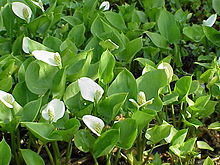Calla
| Calla | |
|---|---|

| |
| Scientific classification | |
| Kingdom: | |
| (unranked): | |
| (unranked): | |
| Order: | |
| Family: | |
| Subfamily: | |
| Genus: | Calla |
| Species: | C. palustris
|
| Binomial name | |
| Calla palustris | |
| Synonyms[1] | |
| |
Calla (Bog Arum, Marsh Calla, Wild Calla, and Water-arum[2]) is a genus of flowering plant in the family Araceae, containing the single species Calla palustris. It is native to cool temperate regions of the Northern Hemisphere, in central, eastern and northern Europe (France and Norway eastward), northern Asia and northern North America (Alaska, Canada, and northeastern contiguous United States).[1][3][4][5]

It is a rhizomatous herbaceous perennial plant growing in bogs and ponds. The leaves are rounded to heart-shaped, 6–12 centimetres (2.4–4.7 in) long on a 10–20 centimetres (3.9–7.9 in) petiole, and 4–12 centimetres (1.6–4.7 in) broad. The greenish-yellow inflorescence is produced on a spadix about 4–6 centimetres (1.6–2.4 in) long, enclosed in a white spathe. The fruit is a cluster of red berries, each berry containing several seeds.[6][7]
The plant is very poisonous when fresh due to its high oxalic acid content, but the rhizome (like that of Caladium, Colocasia, and Arum) is edible after drying, grinding, leaching and boiling.[8][9][10]
The genus formerly also included a number of other species, which have now been transferred to the separate genus Zantedeschia. These plants, from tropical Africa are, however, still often termed "calla lilies", but should not be confused with C. palustris.
References
- ^ a b Kew World Checklist of Selected Plant Families
- ^ Dickinson, T.; Metsger, D.; Bull, J.; & Dickinson, R. (2004) ROM Field Guide to Wildflowers of Ontario. Toronto:Royal Ontario Museum, p. 62.
- ^ Govaerts, R. & Frodin, D.G. (2002). World Checklist and Bibliography of Araceae (and Acoraceae): 1-560. The Board of Trustees of the Royal Botanic Gardens, Kew.
- ^ Herkert, J.R. & Ebinger, J.E. (eds.) (2002). Endangered and Threatened Species of Illinois: status and distribution 1: 1-161. Endangered species protection board, Springfield, Illinois.
- ^ Sabirova, N.D. & Sabirov, R.N. (2011). New and rare vascular plant species of Northern Sakhalin. Byulleten' Glavnogo Botaniceskogo Sada 197: 80-86.
- ^ Flora of North America, vol 22, Water arum, wild calla, Calla palustris Linnaeus, Sp. Pl. 2: 968. 1753.
- ^ Flora of China, Vol. 23 Page 17, 水芋 shui yu, Calla palustris Linnaeus, Sp. Pl. 2: 968. 1753.
- ^ A Dictionary of Flowering Plants and Ferns - JC Willis
- ^ Plants for a Future: Calla palustris
- ^ Pharmacognosy, Wild calla-Calla palustris-Poisonous plants
- Blanchan, Neltje (2002). Wild Flowers: An Aid to Knowledge of our Wild Flowers and their Insect Visitors. Project Gutenberg Literary Archive Foundation.
External links
- Go Botany, New England Wild Flower Society, Calla palustris
- Missouri Gardening, plant finder, Gardening Help
- North Carolina State University Cooperative Extension
- Lilies Water Gardens
- Connecticut Botanical Society, Wild Calla (Water Arum)
- Minnesota Wildflowers
- University Botanic Gardens at Ljubljana
- Hepburn quote

